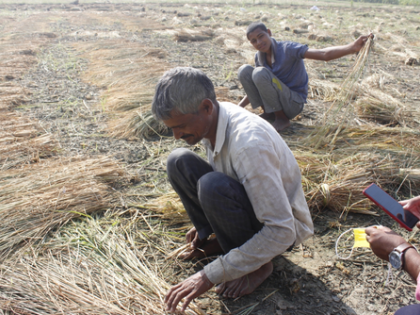Gujarat: Nal Kantha Scheme to bring irrigation to 39 villages
By IANS | Updated: September 8, 2025 21:15 IST2025-09-08T21:13:54+5:302025-09-08T21:15:06+5:30
Gandhinagar, Sep 8 The Gujarat government has rolled out the ambitious Nal Kantha Yojana, a Rs 1,536.86 crore ...

Gujarat: Nal Kantha Scheme to bring irrigation to 39 villages
Gandhinagar, Sep 8 The Gujarat government has rolled out the ambitious Nal Kantha Yojana, a Rs 1,536.86 crore irrigation project aimed at providing water to 39 villages across Sanand, Bavla, and Viramgam talukas of Ahmedabad district, covering 35,486 hectares of farmland.
Replying to a question in the Assembly, Water Resources Minister Rushikesh Patel said the scheme will integrate tail-end villages into the Narmada command area, ensuring irrigation through a network of pipelines and canals, while also strengthening connectivity under the Narmada and Fatehwadi canal projects.
The plan includes interlinking 23 lakes and earthen dams to maximise water availability. The first phase, with an investment of Rs 377.65 crore, is near completion.
It includes laying 26.18 km of MS pipeline, of which 22.78 km has already been installed as of July 31, 2025. Key works include lining the Godhavi-Goraj drain, linking it with the Fatehwadi canal, creating connections from the Dholka and Sanand branch canals, and installing new pipelines up to the Ghoda feeder drain from the Saurashtra branch canal.
For the second phase, the government has earmarked Rs 1,154.65 crore and initiated the tendering process.
This phase will extend the main pipeline to reach the farthest villages, supported by a 348 km-long network - 157 km of MS pipelines and 191 km of DI pipelines. To ensure efficient distribution, sub-lines will branch from the main line, with irrigation water supplied through dedicated outlets every 25 to 40 hectares.
Once operational, the scheme is expected to double farmers’ seasonal incomes by making irrigation water available year-round. Gujarat has a predominantly agrarian base with around 62 per cent of its population dependent on agriculture and allied activities.
According to the latest Agriculture Census and state government estimates, the state has over 60 lakh farmers, of which nearly 84 per cent are small and marginal farmers holding less than two hectares of land.
Gujarat’s total cultivable land is around 98 lakh hectares, with major crops including cotton, groundnut, bajra, wheat, maize, and pulses, along with horticulture crops like bananas, dates, mangoes, and vegetables.
Disclaimer: This post has been auto-published from an agency feed without any modifications to the text and has not been reviewed by an editor
Open in app